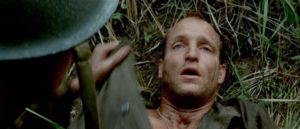The Thin Red Line (1998). Written and directed Terrence Malick. Starring James Caviezel, Sean Penn, Nick Nolte, and Elias Koteas. 170 mins; rated R. Metacritic: 78%; Rotten Tomatoes: 79%.
Films have not historically done much with death. By this, I mean real actual dying. In general movies have greatly prettified the usually stark and often gruesome means by which humans leave this world, bathing the process in muzak, gauzy lighting, and last-breath last words of farewell and/or wisdom. And usually it’s gush, just short of sugarplums dancing in the soul of the deceased. Oh, please. To be fair, though, it is a daunting problem, especially for those filmmakers, now a fast vanishing few, who have some notion of a post-bodily existence of some sort, namely what we have traditionally called an afterlife. There’s Carl Theodor Dreyer in Ordet wherein, lo, a resurrection transpires, though that sort of evades the question posed here. And there’s Ingmar Bergman, of all people, who features the death of Agnes, the saintly of three sisters, two of whom are diabolical.
There is one filmmaker, though, who embraces the challenge full-heartedly, and that is, as one might guess, Terrence Malick, a fearless Texan with camera (or binoculars, him being an avid birdwatcher). In his towering WW II film of the battle for Guadalcanal, The Thin Red Line (1998), Malick closely chronicles numerous violent deaths; it is, after all, a war film. Three receive particular attention. The first is the accidental death of gnarly Sargent Keck (Woody Harrelson), who dies suddenly by his own grenade. There Malick chronicles the whole of his dying, from explosion to death and brief aftermath, a process that takes all of three minutes, an eternity of screen time, especially for a death sequence. It is stark, and death is abrupt, and his cohorts are amply horrified and unsettled, as well they should be. In Keck’s death several clearly confront with inescapable immediacy the fragility and tenuousness of their own existence. The only one who seems unsurprised or unfrightened by death’s horror is Private Witt (James Caviezel), who is more engaged in consoling Keck than in calculating his own risk in a war zone.

And there’s also the death of Private Beade, a sweet-faced young soldier, to whose dying Malick gives a minute and half of screen time. Here Malick pays no heed to the particular means of war that has brought about Beade’s demise. Rather, and in stark contrast to Keck’s death, viewers see both the care of others and, surprisingly, what Beade himself sees as he approaches death: light sliding through trees and holes and leaves. Amid his evident physical pain and his sorrow at dying, Beade at one point bids his captain to look at what he sees. Indeed, Beade’s vision seems at this point to go what we might call quasi-mystical, reckoning with a world transfigured from dirt and blood to light and delicacy. Beauty consoles—or reveals.

Here Malick’s suggestion that death can be something other than terror prepares the way for the last of three.
The third is the very surprising, peculiar, and cinematically spectacular death of the film’s main character, Private Witt, whose passing is no less violent but oh-so-different. All of these judgments proceed from the fact that in Witt’s death Witt himself does not die. The wonder is that Malick finds the cinematic means to the pull that off—namely, the passage of the soul into a plausible afterlife. More startling still is the sort of afterlife into which Witt travels. And surprise, it all seems more than plausible, experientially and psycho-emotionally. And yes, spiritually too, I guess, though that is a word that should be banned, so encrusted is it with goop and mush. Late in the film, Witt undertakes a diversionary sprint through the woods, whooping and calling, to divert the attention of an approaching unit of Japanese troops from Witt’s beloved Charlie Company. He emerges into a clearing to find himself surrounded by an armed host that has aimed its many rifles directly at him. Meanwhile, he hangs on to his rifle as the enemy leader shouts at him in Japanese, no doubt to drop his weapon.

While all of that action transpires externally, and it is pretty dramatic and conventionally exciting within the genre, Malick begins to shift away from it to convey the substance of Witt’s mind as he stands surrounded in the clearing. Instead of the panic and thoughts of escape one might expect, Witt stands in the center of the clearing with a detached, even rapt expression on his face, as if he is attending to something other than the swarm of enemy surrounding him.

At one point Witt begins to raise his rifle, and he is immediately shot and begins falling, at which point the camera cuts to observe light pouring through the forest canopy (the shot rather exactly repeats the second shot in what is in effect the film’s dialogical prologue).

That is then followed by a long sequence in which viewers watch Witt, full of delight, swimming underwater with indigenous boys while AWOL on a Micronesian paradisal island (that long sequence opens the film).

Midway through that sequence a gunshot is heard, the same that kills Witt, but the recollection of delight and play does not cease, continuing on for another few seconds.
What Malick has given viewers, then, is two perspectives on Witt’s death. The first is external, watching Witt surrounded with that strange gaze upon his face. The other repeats what Witt experiences internally “where the meanings are” (Emily Dickinson). In short, Malick records Witt’s death from an external “objective” perspective and also from Witt’s own inward experience of his capture and death. The kill shot fires, but Witt’s mind and soul persist in its present recollection of beatific splendor and delight or, in the words of folk hymn “Simple Gifts,” the “valley of love and delight.”
Instead of fear and flight, Witt revels in sensuous delight and, apparently, all that such rapture betokens about the nature of the universe, namely that it is somehow or another, mysteriously, infused by a sort of radical delight that suggests a benign creator who packed sensuous beauty of all kinds into the materiality of the sensate world. That any part of this world, and especially amid a war zone, can convey and sustain such thorough and intense delight comes as shock and, well, good news insofar as it argues that, despite enveloping pain and darkness, light shines still.
Malick here offers persuasive cognitive heft for the salience of Witt’s experience of the world and death. It is not anti-rational, though it is a sort of non-rational cognition that emerges from within the depths of selfhood. And it is still very much empirical experience, though Witt registers a world very different from the one accessible to and analyzed by science. As Witt says to Welsh in one of their debates about the character of this world, he has “seen another world.” Or he has seen the same world, though a very different set of goggles perceives a very markedly different world from the nothingness read by Welsh and others in the film–so much so that what Witt senses a wholly different sphere of being, a world infused by “glory” that shines amid and despite the horrors of the gruesomeness of warfare, something too readily excused by “necessity” and blarney about valor.
That does not make Witt either non-empirical or irrational, for Witt is deeply anchored in this world, seeing not phantoms but ever so palpable trees and birds, and furthermore, Witt thereafter strives to reckon with his experience rationally by asking throughout what it all means, continually trying to find a philosophical or religious frame that might explain his distinctive sense of the world amid the protracted crisis of combat and death.
Witt finds his answer in his own death. Instead of blackness or nothingness, the illimitable glory of the ordinary persists even after he falls to physical oblivion. The film, then, becomes a revelatory take on the radical love that pervades all of creation, in the natural and human worlds, in this life and beyond.
All 5 entries on this film are written by Roy Anker.
Sign Up for Our Newsletter!
Insights on preaching and sermon ideas, straight to your inbox. Delivered Weekly!
Categorized into Death
The Thin Red Line (1998) – 5